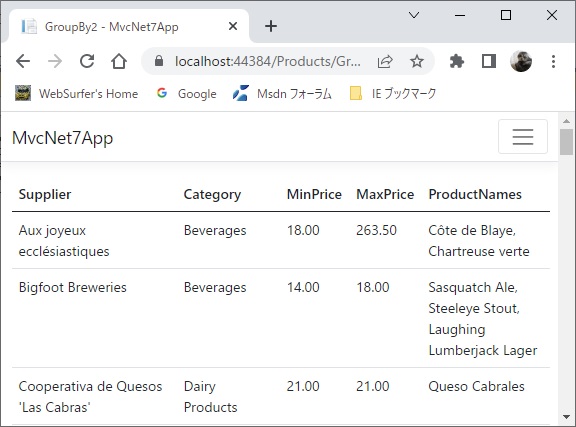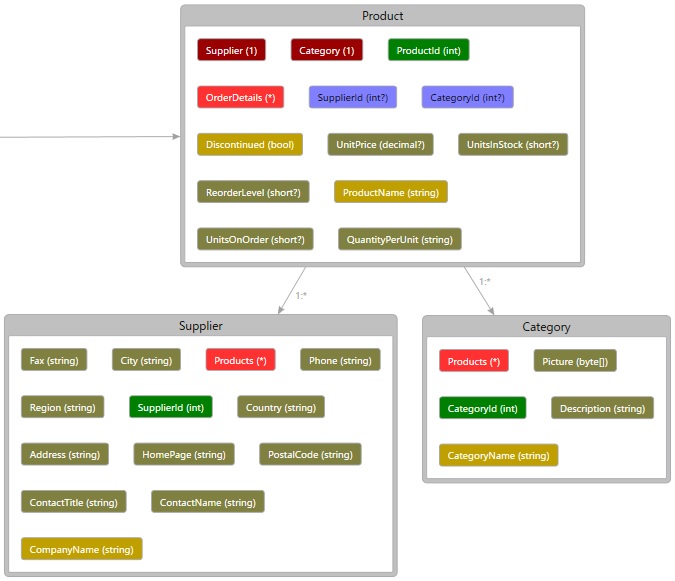by WebSurfer
2023年2月24日 16:56
Linq の GroupBy を使ってグループ分けを行い、グループ分けに指定したフィールドや Sum メソッド等で取得できる集計値だけでなく、それ以外のフィールドの値を取得する方法を書きます。

SQL Server に投げる SQL 文でそのようなデータを取る方法は自分の知る限りなさそうですが、.NET アプリで Linq を使うと何とかなるということで、その方法を備忘録として書いておくことにしました。
上の画像は ASP.NET Core MVC アプリのもので、Northwind サンプルデータベースの Products テーブルのレコードを Supplier と Category でグループ化し、グループに含まれる製品価格の最小値と最大値をそれぞれ MinPrice と MaxPrice として表示すると共に、グループに含まれる製品の名前一覧をカンマ区切りで ProductNames に表示したものです。
ポイントは、グループ化された結果の IGrouping<TKey, TElement> オブジェクトから Select メソッドで ProductName のコレクションを取得し、それらを Enumerable.Aggregate メソッドを使って連結したところです。この記事の最後の方に載せた Controller / Action Method のコードを見てください。
上の画像の ASP.NET Core MVC アプリのコードを下に載せておきます。
コンテキストクラスとエンティティクラスは、リバースエンジニアリングで既存の Northwind の Products, Categories, Supplers テーブルから生成したものです。
エンティティクラスの構造は以下のようになっています。赤茶色と赤はナビゲーションプロパティ、緑は主キーのプロパティ、青は FK 制約付きのフィールドのプロパティです。

Model
namespace MvcNet7App.Models
{ public class GroupedProduct
{
public string Supplier { get; set; } = null!;
public string Category { get; set; } = null!;
public decimal MaxPrice { get; set; }
public decimal MinPrice { get; set; }
public string ProductNames { get; set; } = null!;
}
}
View
@model IEnumerable<GroupedProduct>
@{
ViewData["Title"] = "GroupBy2";
}
<table class="table">
<thead>
<tr>
<th>
@Html.DisplayNameFor(model => model.Supplier)
</th>
<th>
@Html.DisplayNameFor(model => model.Category)
</th>
<th>
@Html.DisplayNameFor(model => model.MinPrice)
</th>
<th>
@Html.DisplayNameFor(model => model.MaxPrice)
</th>
<th>
@Html.DisplayNameFor(model => model.ProductNames)
</th>
</tr>
</thead>
<tbody>
@foreach (var product in Model)
{
<tr>
<td>
@Html.DisplayFor(m => product.Supplier)
</td>
<td>
@Html.DisplayFor(m => product.Category)
</td>
<td>
@Html.DisplayFor(m => product.MinPrice)
</td>
<td>
@Html.DisplayFor(m => product.MaxPrice)
</td>
<td>
@Html.DisplayFor(m => product.ProductNames)
</td>
</tr>
}
</tbody>
</table>
Controller / Action Method
using Microsoft.AspNetCore.Mvc;
using Microsoft.AspNetCore.Mvc.Rendering;
using Microsoft.EntityFrameworkCore;
using MvcNet7App.Data;
using MvcNet7App.Models;
namespace MvcNet7App.Controllers
{
public class ProductsController : Controller
{
private readonly NorthwindContext _context;
public ProductsController(NorthwindContext context)
{
_context = context;
}
public async Task<IActionResult> GroupBy2()
{
// 下のコードで使った Aggregate メソッドは SQL 文に
// 変換できず Linq to Entities では使えないので、こ
// こで List<Product> オブジェクトを取得し、
var products = await _context.Products
.Include(p => p.Category)
.Include(p => p.Supplier)
.ToListAsync();
// 以下で Linq to Objects として処理する
var grouped = products
.GroupBy(p => new
{
p.Supplier!.CompanyName,
p.Category!.CategoryName
})
.Select(g => new GroupedProduct
{
Supplier = g.Key.CompanyName,
Category = g.Key.CategoryName,
MaxPrice = g.Max(p => p.UnitPrice)!.Value,
MinPrice = g.Min(p => p.UnitPrice)!.Value,
ProductNames = g.Select(p => p.ProductName)
.Distinct()
.Aggregate((a, b) => $"{a}, {b}")
})
.OrderBy(gp => gp.Supplier);
return View(grouped);
}
}
}